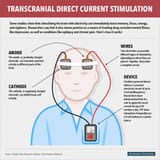Anonymous
ID: LaCtdYVo
6/13/2025, 5:08:54 PM No.507225145
Why aren't you using electric stimulation to double the rate at which you learn things?
>A brain device that can increase learning by up to 40 percent has been revealed by scientists funded by the Defense Advanced Research Project Agency (DARPA). While the device was originally tested on macaques, researchers said it could be a cheap and non-invasive way of "altering functional connectivity in humans" in the future.
>The device is a non-invasive cap that stimulates parts of the brain via electrical currents. It was developed by researchers at HRL Laboratories, California, McGill University in Montreal, Canada, and Soterix Medical in New York.
>In their experiments, the team performed "non-invasive transcranial direct current stimulation"—or tDCS—on a set of macaques. They stimulated the prefrontal cortex and got them to perform a task based on associative learning. In order to get a reward, they had to learn associations between a visual cue and a location. >The macaques would forage for the reward after getting the visual cue.
>The findings, published in the journal Current Biology, showed that macaques in the control group took 22 trials before they had learned to get the reward straight away. It took the tDCS group just 12 trials. The tDCS device accounted for a 40 percent increase in learning speed, the authors say.
https://www.newsweek.com/darpa-device-boosts-learning-brain-connections-692693
>A brain device that can increase learning by up to 40 percent has been revealed by scientists funded by the Defense Advanced Research Project Agency (DARPA). While the device was originally tested on macaques, researchers said it could be a cheap and non-invasive way of "altering functional connectivity in humans" in the future.
>The device is a non-invasive cap that stimulates parts of the brain via electrical currents. It was developed by researchers at HRL Laboratories, California, McGill University in Montreal, Canada, and Soterix Medical in New York.
>In their experiments, the team performed "non-invasive transcranial direct current stimulation"—or tDCS—on a set of macaques. They stimulated the prefrontal cortex and got them to perform a task based on associative learning. In order to get a reward, they had to learn associations between a visual cue and a location. >The macaques would forage for the reward after getting the visual cue.
>The findings, published in the journal Current Biology, showed that macaques in the control group took 22 trials before they had learned to get the reward straight away. It took the tDCS group just 12 trials. The tDCS device accounted for a 40 percent increase in learning speed, the authors say.
https://www.newsweek.com/darpa-device-boosts-learning-brain-connections-692693
Replies:

